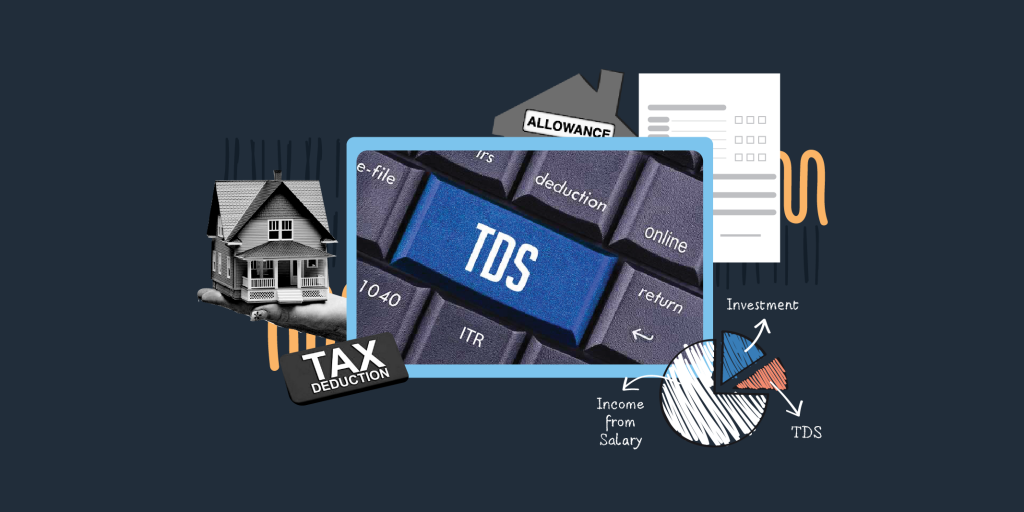Last Updated on Apr 6, 2021 by Manonmayi
Can you recall receiving an email from your employer requesting you to submit your investment declaration form at the beginning of every financial year? Such a hustle, right? But that’s the law and we have to abide by it. Based on this investment declaration that you submit, your employer estimates your taxable income and deducts tax at source every month before paying your monthly salary. Let’s learn more.
This article covers:
How is salary calculated for TDS?
Relevant exemptions and deductions on the components of salary
How does your employer calculate TDS?
Table of Contents
What is TDS?
As the name suggests, TDS is tax deducted at source. As per the Income Tax Act, 1961, an employer deducts TDS when the salary of an employee exceeds the exemption limit of income tax based on the current slab rate for the relevant financial year. The employer then deposits such tax with the government on behalf of you. Once deducted, you can claim the TDS while filing your annual IT return.
What is TDS on salary?
Tax deducted on salary income is TDS on Salary. TDS is deducted under Section 192 and the same is reflected in Form 16 issued by the employer.
What is the purpose of TDS?
TDS is collected so the government has a stable source of revenue through the year. TDS also helps prevent tax evasion.
What is salary income?
In common parlance, salary is a remuneration that an employer pays to the employee as per the terms of the employment contract. In other words, it is the earnings that you receive periodically in exchange of services that you render to an organization. However, every income you earn on rendering services is not salary. If you are a professional, the fees paid by your clients is not salary but ‘Professional Fees’.
As per the Income Tax Act, 1961, salary includes fees, wages, annuity, pension, gratuity, perquisites, profits, commissions and other forms of remuneration that you receive as an employee of a firm.
How is salary calculated for TDS?
Salary is usually calculated as the cost to company (CTC), which includes perquisites too. Perquisites can be fuel subsidy, travel expenses, hotel expenses, and more.
Components of CTC
- Basic salary
- House rent allowance
- Dearness allowance
- Conveyance allowance
- Medical allowance
- Special allowances
- Other allowances
Relevant tax exemptions and deductions
As an employee, you can claim a tax exemption on the following items:
- Claim a standard deduction of Rs 50,000 for FY 2019-20 as against Rs 40,000 available for current financial year
- House rent allowance: claim this if you pay house rent
- Travel or conveyance allowance: claim the amount you spend on commuting to work
- Medical allowance: furnish bills as evidence to claim this allowance
- Other tax deductions under Sections 80C and 80D for investments, insurance premium, and repayment of home loans
TDS is calculated on your total income minus tax exemptions that you claim. Your employer can’t deduct tax on your income without possessing a declaration and proof of investment from you. The above-mentioned tax exemptions each have a maximum limit to the amount you can claim as a deduction.
These exemptions and deductions are available for you to claim in the FY 2019-20. However, with the introduction of the new tax regime for those filing returns for the FY 2020-21, you have the following options:
- File ITR as per the old tax regime that offers various exemptions and deductions
- Opt for the new tax regimes and thus lower tax rates but let go of numerous exemptions and deductions including those falling under Sections 80C and 80D
How does your employer calculate TDS?
You need the following details to calculate TDS:
- Calculate your total earnings for the year, which includes perquisites, bonus, and commission
- Collect a declaration from you about investments you have made or are planning to make. They then collect proof of investment at year-end. This is required to approve tax exemptions
- Calculate the eligible amount for tax exemption. Deduct all eligible exemptions from your gross annual salary. The resultant is the taxable income
- Deducts TDS based on the tax slab applicable to you
- Deposit TDS with the central government within the scheduled time
Things to note
- Employers generally calculate your tax at the beginning of the financial year
- TDS for a particular year is divided by the number of months you are employed with an employer/s
- In case you don’t have PAN, TDS is deducted at the rate of 20%, excluding cess
FAQs
Who can deduct TDS under Section 192?
Employers can deduct TDS on salary. Ergo, your employer can be of any of the forms below:
- Individuals
- Hindu undivided family (HUF)
- Partnership firms
- Private/public companies
- Trusts
- Co-operative societies
When is TDS on salary deducted?
TDS is deducted under Section 192 at the time of the payment of salary. Your employer cannot deduct TDS when on the accrual of salary. That said, TDS is also deducted if on advance salary and arrears that you receive. TDS is not deducted in case your estimated salary doesn’t fall under a tax slab.
Can you claim HRA as a deduction for TDS?
Yes. But you can only do so if you’re opting for the old tax regime.
How much can you claim as a deduction under Section 80C?
You are allowed to claim up to Rs 1.5 lakh as an exemption under Section 80C
Which investments or expenses can you claim under Section 80C?
You can claim deductions such as:
- Employee’s share of EPF contribution
- Public Provident Fund (PPF) contribution
- Life insurance premium
- National Savings Certificate (NSC)
- Children’s tuition fees
- Unit-linked insurance plans (ULIP)
- Equity-linked savings schemes (ELSS)
- Repayment of home loan principal
- Contribution to LIC’s notified annuity plan
- Deferred annuities
- Senior Citizens Savings Scheme (SCSS)
- Sukanya Samriddhi Account (SSA)
- 5-year tax-saving FD
- Subscription to notified deposits scheme/notified securities
- Subscription to National Housing Bank’s Home Loan Account Scheme
- Subscription to NABARD’s notified bonds
- Subscription to debentures/equity of approved eligible issues
Can you know the amount of TDS deducted from your income?
Yes. There are ways:
- Ask your employer to furnish a TDS certificate
- Check Form 26AS under “View Your Tax Credit” facility on www.incometaxindia.gov.in
What happens if the employer fails to deduct TDS?
The onus of deducting TDS on salary is your employer’s. However, if they fail to deduct TDS, you will have to pay your tax liability when filing your ITR.
Why doesn’t Form 26AS reflect the correct TDS deducted?
If your employer has deducted TDS on salary but the same is not reflected in Form 26AS, it may be for the following reasons:
- Your employer may not have deposited the tax collected
- Your employer may not have filed the TDS statement
- Your employer may have mentioned incorrect PAN (yours) in the TDS statement
What to do if there is no TDS credit in Form 26AS?
In this case, ask your employer to rectify errors so as to reflect correct TDS
Can you still claim TDS in case your employer hasn’t furnished your TDS certificate?
Yes, only if the TDS credit appears correctly in Form 26AS
- Top Large Cap Funds 2025: Discover Blue Chip Performers - Mar 27, 2025
- Gilt Funds in India: Features, Meaning, and Advantages - Mar 13, 2025
- Best Index Funds in India 2025: Top Performing Mutual Funds - Mar 13, 2025




